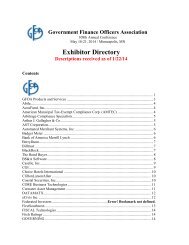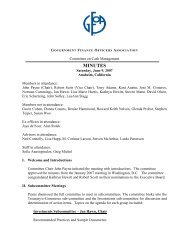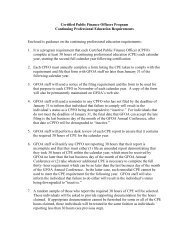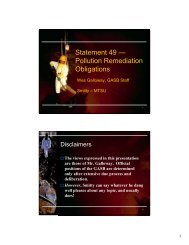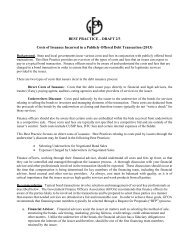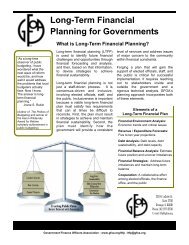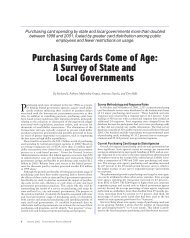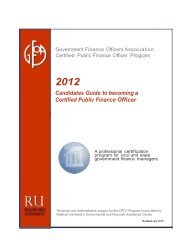Fiscal First Aid Quick Reference - Government Finance Officers ...
Fiscal First Aid Quick Reference - Government Finance Officers ...
Fiscal First Aid Quick Reference - Government Finance Officers ...
You also want an ePaper? Increase the reach of your titles
YUMPU automatically turns print PDFs into web optimized ePapers that Google loves.
<strong>Fiscal</strong> <strong>First</strong> <strong>Aid</strong> <strong>Quick</strong> <strong>Reference</strong><br />
Develop Cash Flow Reporting.<br />
By Sofia Anastopolous, Vice President, Client Service, Chandler Asset Management, and<br />
Michael E. Bailey, <strong>Finance</strong> Director, City of Redmond, Washington<br />
Introduction<br />
Cash flow forecasting is an estimate of cash sources and uses, and the resulting balances, during<br />
a given period (daily, weekly, monthly, annually). This forecast measures the organization’s ability<br />
to meet its liquidity needs and provides early warning of unfavorable trends.<br />
Cash flow forecasting can determine what dollar amount of the portfolio needs to remain liquid to<br />
meet disbursement obligations, generally within a six-month period. Also, it can identify core<br />
funds, or those funds available for longer-term investing. For instance, cash flow forecasts can<br />
help identify reasonable maximum and weighted average maturities of investments.<br />
Cash flow forecasting should be done throughout the organization. This allows the jurisdiction to<br />
coordinate spending patterns and balance the flow of funds.<br />
In a financial crisis, cash flow reporting takes on renewed importance. Cash is critical for shortterm<br />
operations. It pays the salaries and rents, and buys the equipment, supplies, and tools.<br />
<strong>Government</strong>s in a financial crisis should develop monthly and perhaps even weekly cash flow<br />
forecasts.<br />
Steps to Take<br />
I. Gather information from several sources:<br />
A. Monthly financial statements, bank statements, accounts payable and receivable<br />
information, and any other historical information related to cash transactions. This<br />
information gives historical data and can help identify peaks and valleys in cash flows.<br />
B. Current budget, which provides information on future revenues and expenses and can<br />
identify potential deviation from historic patterns.<br />
C. Capital projects and their estimated draw schedules.<br />
D. Current debt service.<br />
E. Investment activity, including maturities and interest payments. The timing can help<br />
match maturities to disbursement obligations.<br />
II. Use the above information to predict upcoming receipts and disbursements, and plan future<br />
investments and borrowing requirements.<br />
A. Revenue items should be limited to four or five major sources, with additional revenues<br />
lumped together as “other.”<br />
1. Prepare a monthly schedule of prior receipts.<br />
2. Then calculate a simple three-year average.<br />
3. Use this average to determine the percentage of each revenue source contributes to<br />
the total.<br />
4. Adjust these percentages for any planned changes in timing or amount. This is<br />
important during economic slowdowns, when abrupt shifts in sensitive revenues and<br />
expenditures can wreak havoc on historical trend information.<br />
B. Prepare expense or disbursements the same way as revenues.<br />
1
<strong>Fiscal</strong> <strong>First</strong> <strong>Aid</strong> <strong>Quick</strong> <strong>Reference</strong><br />
Develop Cash Flow Reporting.<br />
1. Categorize expenses by major type such as payroll, utility payments, debt service<br />
payments, capital expenditures, materials and supplies, and other vendor and<br />
miscellaneous payments.<br />
2. Prepare a monthly schedule of historical disbursements.<br />
3. Calculate a three-year average.<br />
4. Adjust for anticipated variations and trends.<br />
III. Use forecast revenues and expenses to create a cash flow forecast.t<br />
IV. Include all available cash and investments in the beginning balance.<br />
V. Add expected receipts to the beginning balance and subtract expenses.<br />
VI. The result will be the net cash position, which determines what course of action to take.<br />
Excess cash should be invested to maximize investment income. Deficit balances may<br />
require short-term financing.<br />
Applications of Cash Flow Reporting<br />
Managing financial stress. Organizations can use cash flow forecasts to identify current liquidity<br />
issues and trends that may develop into problems in the short-term or even in the long-term. .<br />
Sizing fund balance. Cash flow helps identify working capital needs. Cash flows that are volatile<br />
and have wide variance between high and low points for given periods may suggest a need for a<br />
higher working capital reserve.<br />
Communication tool. Cash flow forecasts can help illustrate the reality of an organization’s<br />
liquidity situation. Such communication can prove valuable when dealing with stakeholders<br />
(elected officials, rating agencies, taxpayers, and constituents).<br />
Investment management. In normal interest rate environments, longer maturities typically have<br />
higher yields. With the information garnered from a reliable cash flow forecast, a government can<br />
identify what dollar amount of the portfolio needs to remain liquid to meet disbursement<br />
obligations, and it can identify those funds available for longer-term investing.<br />
Evaluation<br />
• Reliable cash flow forecasting is key to prudent financial management.<br />
• Cash flow forecasting is essential in a financial crisis.<br />
• Cash flow forecasts can provide early warning signs of liquidity problems.<br />
• Cash flow forecasting helps diagnose imbalances in sources and uses and can highlight<br />
patterns that might affect long-range financial position.<br />
• Cash flow forecasting can provide information to help manage liquidity problems.<br />
• Cash flow forecasts can help officials take prompt corrective action and plan for<br />
contingencies (accelerate revenue collections, reduce expenditures, make informed<br />
decisions about short-term borrowing).<br />
2
<strong>Fiscal</strong> <strong>First</strong> <strong>Aid</strong> <strong>Quick</strong> <strong>Reference</strong><br />
Develop Cash Flow Reporting.<br />
Resources<br />
o Shayne C. Kavanagh and Christopher J. Swanson, “Tactical Financial Management:<br />
Cash Flow and Budgetary Variance Analysis,” <strong>Government</strong> <strong>Finance</strong> Review, October<br />
2009.<br />
o Erik W. Bush, “Optimizing Funds with Cash Flow Forecasting,” <strong>Government</strong> <strong>Finance</strong><br />
Review, August 2005.<br />
o Michael E. Bailey, “Do You Know Where Your Cash Is?” Treasury Management<br />
Newsletter, February 2010.<br />
o Michael A. Gallanis, “Cash Forecasting for the Public Sector,” Treasury Management<br />
Newsletter, July 2003<br />
(http://www.estoregfoa.org/StaticContent/staticpages/PI0703.html).<br />
o GFOA Best Practice: Use of Cash Flow Forecasts in Operations (2005 and 2008)<br />
(http://www.gfoa.org/downloads/CashFlowsFINAL.pdf).<br />
o David P. Higgins, Essentials of Treasury Management (Bethesda, MD: Association<br />
for Financial Professionals, January 2005).<br />
3



